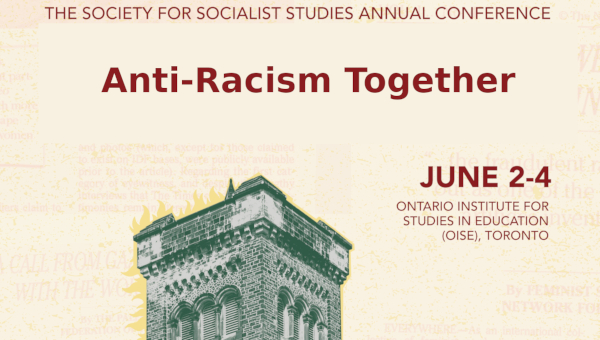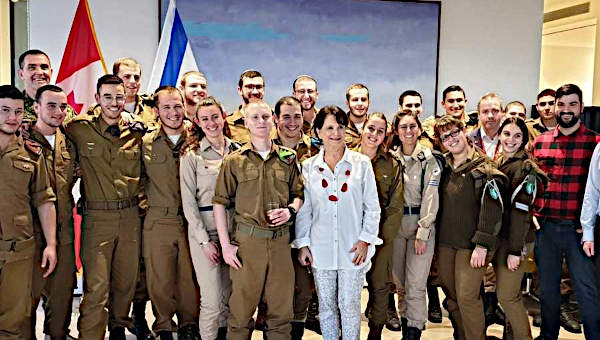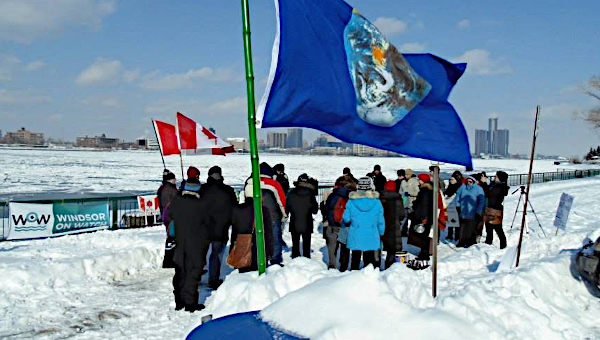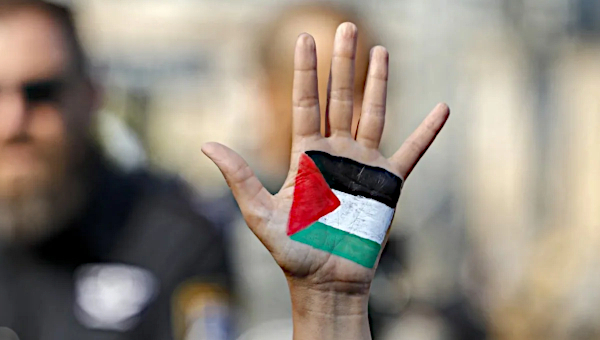Trudeau Government Acknowledges Nazi Genocide Against Roma
More then 50 people of all ages joined in Toronto August 2, 2018, in an international day of remembrance and recognition of the Romani Holocaust (Porajmos) in Europe. They heard Arif Virani, federal member of parliament for Toronto Parkdale-High Park, read a statement issued that day by Justin Trudeau’s government which said, in part:
“On Romani Genocide Remembrance Day, we honour the memory of over 500,000 Romani who were persecuted and murdered by the Nazis and their collaborators in Europe. This genocide and the unspeakable violence inflicted on the Romani people are not widely known by the public, making them the ignored victims of WWII.”
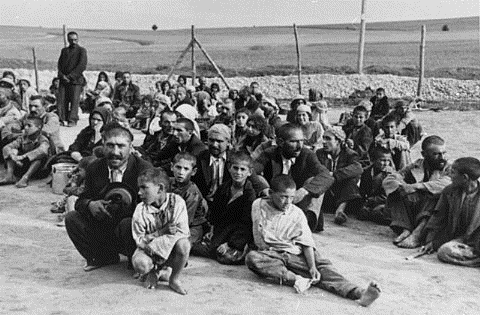
The statement is “the result of three years of work by the Roma (Gypsies) and their friends” according to Michael Butch, president of the Toronto Roma Community Centre and founder of the Gypsy Rebels band. It is a welcome shift, even if only implicit, from the pattern of discriminatory and defamatory actions by the federal government over the last two decades, particularly under the government of Stephen Harper (2006-15).
A Montreal-based group defending Roma human rights, “Romanipe,” laid out the statement’s deeper implication:
“At a time when acts of racism, hatred and violence against Romani continue to be normalized, preserving the memory of past atrocities and raising awareness about the dangers of impunity becomes not only a right but a duty… The lessons of this tragedy serve to advance the human rights situation of Romani communities at home and abroad.”
Porajmos Remembered
The Toronto event highlighted the 74th anniversary of Roma resistance in Auschwitz, when thousands of Roma prisoners fought back courageously against Nazi guards.
Roma shared a common fate with Jews in countries under Nazi rule. In A People Uncounted, a video on the Roma Holocaust (or Porajmos) a Jewish survivor recalls how Jews and Roma shared ties of mutual aid and respect. “Our ashes are mixed with theirs in the ovens.”
In Auschwitz the majority of Jewish arrivals were sent straight to their death. The Roma, by contrast, were confined at Auschwitz in a separate camp, the Zigeunerlager, marked down to die of starvation, disease, brutal treatment, and sinister medical experimentation.
On May 16, 1944, heavily armed guards assaulted the Roma camp under orders to deliver the 6,000 Roma prisoners to the gas chambers. Forewarned, the Roma put up a fierce resistance with improvised weapons. At the cost of many casualties, the Roma beat off the attack and lived to fight another day – a triumph with few parallels in the history of Nazi death camps.
On the morning of August 2, the Nazis tried again. First, they removed able-bodied men and dispersed them to other camps, where some survived. That evening, emboldened by this cowardly move, the guards attacked the 3,000 who remained – women, children, and the sick. “The inmates fought a fierce battle with sticks and rocks” before ultimately being herded to the gas chambers, recounts Lizzie Isaacs. “Witness accounts say that the Romanies fought to the very end…. That night over 3,000 were murdered and the bodies burnt in the pits.”
In all, Cynthia Levine-Rasky writes:
“Estimates of the total number of Roma killed between 1933 and 1945 range from 500,000 to 1.5 million. The variance is due not only to the lack of records for the geographically dispersed camps in which the Roma were detained but also to the way in which so many were killed in the fields, villages, and remote areas where they lived.”1
The Nazis did not bother to catalogue the names and birth-places of the Roma as they often did for other “Untermenschen” (subhumans), including my Jewish mother. The Roma victims thus, remain “a people uncounted.”
Origins of the Roma
Erroneously called “Gypsies” in the English-speaking world by those who thought they came from Egypt, the Roma actually originated in North-Central India early in the 11th century.
About 400 years later, they moved into and across Europe, where they often faced persecution. Ronald Lee, a co-founder of the Toronto Romani Community Centre and historian, explains that the Roma’s strategy for survival was to “become part of the feudal system in Central/Eastern Europe and to become totally nomadic in Western Europe, able to move from one country to another as persecution waxed and waned.”2
Although scattered across Europe and divided into many communities, the Roma retained a common culture and a common language, based on speech in their original home in the north-west India sub-continent. Today Romani is spoken worldwide in many dialects.
Lee tracks the relentless mass killings (samudaripen) of Roma dating back to 15th century Europe. “The Christian Popes and their clergy accused the Roma of having made the nails for the cross of Christ…. Because the majority of their people are dark-skinned, they were also accused of devil worship as ‘imps of Satan’…. The Protestant religions were equally hostile to the Roma and condemned them as work-shy parasites and immoral hedonists, the antithesis of Martin Luther’s hymn-singing, hard-working, joy-denying, witch-burning Puritans…”3
But the Roma Holocaust arose not from Mediaeval witch-hunts but from twentieth century social conflicts in Europe. Even before 1938, when Nazi leader Heinrich Himmler proclaimed the goal of subjecting the Roma to a “final solution” – that is, to extermination, a number of governments were taking steps against the Roma.
At the August 2 commemoration in Toronto, a Roma high-school student and recently arrived refugee recalled that in his country, Hungary, “anti-Romani laws were enacted beginning in 1928, making it very hard for Roma to get jobs and subjecting them to police discrimination and surveillance.”
“During the Second World War,” the student continued, “the Czechs rounded up the Roma and handed them over to the German occupiers.” This procedure was similar to the situation in France, where I then lived; the French Vichy government took the initiative in rounding up the Jews and handing them to the Nazis.
“In Hungary,” he continued, “in the summer of 1944 the Romani were confined in ghettos and subjected to forced labour. Two of our young refugee’s family was sent to Auschwitz to die.”
The documentary A People Uncounted explains that in Austria, during the depression of the 1930s, mass unemployment hit the Roma the hardest, forcing them out of their traditional trades and onto the municipal social assistance rolls. Many local communities petitioned the Nazi government to ease their burden by removing the Roma, sometimes even paying for this service. But this did not happen in every case. “If a local community does not permit persecution,” the film tells us repeatedly, “it does not happen.”
After the overthrow of Nazi rule, the surviving Roma in Eastern Europe came under Communist rule, which freed them from organized racism and discrimination while providing employment and economic security. Lee notes that Roma in Yugoslavia and the Soviet Union enjoyed a measure of cultural autonomy, but government policies across Eastern Europe as a whole aimed at assimilation of the Roma, which they strongly resented. Communist rule “was a two-edged sword,” Lee says.
Restored Capitalism Brings Racist Revival
Since the end of Communist rule in 1989-90, the Roma in Eastern Europe have again faced murderous persecution at the hands of racist groups.
When Communist rule ended, a shock-therapy transition to capitalism deprived many Roma of employment, while fueling a revival in several countries of the old racist and Nazi-era hatreds. Increasingly, rightist regimes encouraged resentment against the “other” – the Roma – who were victimized by heightened violence and xenophobia.
A video documenting such violent attacks against Roma in the Czech Republic was shown to the August 2 Toronto commemoration. In it, an anti-Roma activist declares, “We all hate the Roma together here.”
Ronald Lee told the Toronto meeting of a June 23 attack on a Roma camp near Lviv, Ukraine, by a gang of masked attackers suspected of membership in a far-right nationalist gang. David Popp, 23, was stabbed to death in his sleep, and several other Roma were wounded. Eight attackers were arrested. Three days later, a pro-Roma solidarity action in Lviv chanted, “Nazis are around and the state is protecting them.” 4
Lee echoed this thought, noting that Canada backs the Ukraine regime with soldiers and military aid. “I have a photo of Ukrainian soldiers, armed by Canada, waiving Nazi flags,” he told the August 2 meeting.
There is a pattern of government complicity with these crimes in several countries, writes British anthropologist Michael Stewart:
“There are now elected official, parties and civic movements for whom “problems with the Gypsies” lie at the heart of their grievances. This is something wholly new on the European political scene. Traditional European anti-Gypsy politics talked of Roma as nuisance, as a “public scandal,” even as a plague descended on the hardworking citizens. But never, not even in the 1930s, as a fundamental source of national woe. Parties have now emerged in Bulgaria and Hungaria with significant public support [which] place “the Gypsy menace” at the absolute centre of their politics.”5
Conditions faced by Roma in several East European states now resemble what they experienced in the run-up to Nazi rule. A People Uncounted calls these conditions “pre-genocidal,” in the sense that they create conditions in which genocidal attack could take place.
In this context, it is not surprising that many thousands of Roma over the past three decades have sought to enter Canada as refugees.
Roma Seek Refuge in Canada
Roma have lived in Canada for more than 100 years, as what Ronald Lee terms an “unrecognized patch in the national quilt.” They now number about 100,000.
Between 1998 and 2015, Canada received roughly 20,000 refugee claims from Roma in Europe. The Roma made up only about 5% of the total refugee claimants – a barely perceptible bump in the flow of applicants that has was generally declining in those years. (Source: www.canada.ca). Nonetheless, this flow was sufficient to elicit the Canadian government’s first-ever response to Roma immigration. It was unfavourable. Ottawa erected legislative and policy barriers to Roma settlement.
“Our Centre was born in 1997, mostly to provide services to a large number of Roma refugees fleeing from persecution and tyranny in Czechoslovakia,” Michael Butch explained. “At present, most Roma refugees flee from Romania, Hungary and the Ukraine.”6
Between 2010 and 2012, 8,605 asylum seekers arrived in Canada from Hungary – most of them were Roma impelled to leave by a wave of violence and intimidation. The Harper government responded with measures that drove the “success rate” — acceptance of Hungarian refugee claimants during those years — below 10%.
As part of this program, Citizenship and Immigration Minister Jason Kenney took exceptional measures to deter Roma from seeking safety in Canada. During a diplomatic visit to Hungary on October 9, 2012, in an unmistakable reference to the Roma, Kenney declared that he would stop “the abuse of our system and generosity by bogus asylum claimants.” The minister backed up this gross insult with a $13,000 billboard and media campaign to let to Roma know that Canada’s refugee determination system had changed and was now unfriendly to Roma refugee claims.7
Jason Kenny’s approach, in Ronald Lee’s opinion, is reminiscent of the notorious statement of a Canadian immigration official in 1939 regarding potential Jewish immigration, “none is too many.”
Since Justin Trudeau replaced Harper as prime minister, “the refugee situation is much improved,” according to Michael Butch, but many barriers that obstruct Roma refugees remain in place, and the number of Roma claimants is much reduced.
Resilience and Optimism
As for those Roma refugees who managed to win acceptance in Canada, how have they fared? Levine-Rasky reports her findings, based on extensive interviews with Roma refugees in Toronto. in an article, “Determined Nation,” and her book, Writing the Roma.
Levine-Rasky’s interview subjects that have run into their share of obstacles, setbacks, and – especially from landlords – outright anti-Roma discrimination. Yet her Roma informants often stress that despite the challenges, Canada offers them freedom, possibilities to enjoy life, and a future for their children. Among their responses:
- “Here they treat you as a human being. They don’t treat you like an idiot, or someone who doesn’t know any thing. You can use your brain. They treat you like a normal person… They didn’t treat me like a Gipsy.” (Frank, arrived 2000) (“Determined Nation,” p. 58)
- “[A]t university … I just saw, Cynthia, oh my God the people. Every kind of people just working with each other and I have the same opportunity what they doing.” (Lylugyi, arrived 2000) (Writing the Roma, 156.)
- “[My children] they’re so happy, because the whole class loves them, they love them. But it’s not love, it’s just a normal treatment…. When I go outside, for walking and they [are] always asking … It’s like normal fashion. ‘Where is your baby ? How is your kid? How is your life?’ … Those kind of questions normal here in Canada.” (Katalin, arrived 2011), “Determined Nation,” p. 58.
In their own words, the refugees explain that it is hard to leave their past behind, and they are still wary of people who hated, abused, and physically hurt them. In Toronto, they learn that they “don’t have to be ready to fight” to defend themselves against the skinheads; there are no guards, no police, no harassment.” They begin to feel that they are “living in a free country.” (Writing the Roma, p. 155.)
Women think about broadening their scope with education. “I can do everything I want to do and I can be anybody.” They modify their traditional role as wife and mother: “Women should study … Cultural things are okay at home, but if they want to integrate, they have to let go of some things.” (Writing the Roma, p. 156.)
In reading these testimonies, I was reminded of an emphatic statement in A People Uncounted: “If a local community does not permit persecution, it does not happen.” The contrary is also true. When the local community reacts with simple human decency, a great deal can be achieved.
I owe my life to that concept: as a Jew I survived the Nazi holocaust thanks to the courageous humanity of a welcoming community in rural France.
We have much to learn from the Roma and other immigrants that make up patches in the quilt of Canadian life today. They help us decide whether we are going to do the humane thing for people who seek refuge. We will soon be facing many more needing a helping hand. Even within our own borders, the fires and floods of climate change will disrupt the lives of thousands.
Will the community mindset in Canada be to protect only our belongings and ourselves? Or will we reach out for an inclusive, loving, peaceful and better future for the entire planet? That is the ultimate challenge symbolized by our response to our new Roma neighbours. •
Resources
- Aaron Yeger (director) and Mark Swenker (producer), A People Uncounted: The Untold Story of the Roma, NFB, 2011.
- Cynthia Levine-Rasky, Writing the Roma: Histories, Policies, and Communities in Canada, Toronto: Fernwood, 2016.
- Cynthia Levine-Rasky, “‘They Didn’t Treat Me as a Gypsy’:Romani Refugees in Toronto,” Refuge, Canada’s Journal on Refugees, 32:3 (2016).
- Cynthia Levine-Rasky, “Determined Nation,” Canada’s History, June-July 1918.
- Ronald Lee, “Post-Communism Romani Migration in Canada,” Cambridge Review of International Affairs, 13:2 (2000).
- Ronald Lee, “A New Look at Our Romani Origins and Diaspora,” Kopachi.
- Lizzie Isaacs, “Remembering Zigeunernacht – The Night of the Gypsies, August 2, 1944,” Travellers Times, August 2018.
- Michael Stewart, The Gypsy “Menace”: Populism and the New Anti-Gypsy Politics, London: Hurst, 2012.
Endnotes
- Writing the Roma, p.71.
- Interview with the author and John Riddell.
- Ronald Lee, “Roma up to and during the Holocaust,” unpublished paper.
- Al-Jazeera.
- The Gypsy Menace xix.
- Interview with author and John Riddell.
- Levine-Rasky, “They Didn’t Treat Me as a Gypsy,” p. 6.


